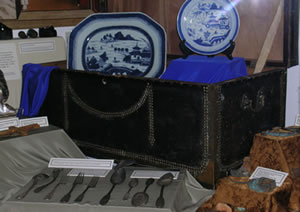Ironically,
the story of redwood logging in Mendocino County begins
not on land but on sea! It has all the elements of a good
modern tale—foreign lands, clashing ambitions, drug
deals, even life-and-death struggles.
Ever since
her Baltimore launching in 1844, the Frolic had
made her reputation and her profits as an opium clipper
between China and India. By 1850 she was no longer a proud
ship nor a profitable investment. Just a year earlier, she
had weathered a typhoon enroute to Shanghai. Only one day
out to sea, the crippled Frolic had to be towed to Hong
Kong where storm damage and dry rot were repaired. Three
months later she sailed to Bombay to pick up one last cargo
of opium, returning to China on May 21, 1850. By then it
was clear to one of her owners, John Heard, that the Frolic
had finally been outrun by time and the new steamships that
were plying the opium sea routes.
While the Frolic
had lost her competitive edge in the opium market, Heard
believed she could still bring a good price in California,
where she could make short runs up and down the coast. He
was planning to sell her there if everything went well on
her last voyage from the China seas. Later, as it happened,
Heard would reconsider. The California Gold Rush had created
a new consumer frenzy as thousands made their way to the
land of gold and dreams. Even as the Frolic's cargo
was being assembled in Hong Kong, Heard learned that his
profits on an earlier consignment to California via the
Eveline was at least 75% on every item and, in
some cases, upwards of 200%. Writing to his uncle Augustine,
the head of the firm, John Heard said that if all went went
well on this California sailing, it might be in their "interest"
to keep the Frolic for this "line of business".
On June 10,
1850, the Frolic left Hong Kong bound for San Francisco.
This time her cargo consisted of Chinese silks, porcelains,
and paintings; silverware; camphor trunks; Edinburgh ale;
ivory fans; jewelry; game boards; combs; umbrellas; and
other goods for eager California shoppers. At her helm was
a 43-year-old captain that had sailed her since her maiden
voyage—Edward Horatio Faucon. While still a young
man, Faucon had been immortalized as the “good captain”
by Richard Dana in his 1840 memoir Two Years before
the Mast.
After an uneventful trip of 6 weeks and 6000 miles, Faucon
was within 100 miles of San Francisco. It was a seemingly
clear moon-drenched night. About 9:30 pm on July 25, the
first officer spotted breakers up ahead. Faucon’s
first reaction was “It’s impossible.”
There wasn't time for a second thought. The Frolic
struck a large rock about a half mile north of Point Cabrillo.
Her rudder snapped, her hulled cracked, and she began to
take on water. Faucon gave the order to lower two lifeboats.
Six crewmen remained on board the Frolic, apparently clinging
throughout the night to her rigging. Faucon headed further
down the coast with the two boats and the remainder of the
crew. By daylight, Faucon and his men had reached a beach
about six miles south of the wreckage near the mouth of
Big River. Faucon decided to hike inland looking for Indians
that might be able to help him and his men. When he found
no one, he returned to the beach. Most of the crew decided
to take their chances on land. Their decision might have
been prompted by the fact that one of the lifeboats had
begun to leak.
With two officers, four oarsmen, and a sick Hindi sailor,
Faucon guided the sturdier boat south, closely following
the coastline. By August 4, he and his crew reached San
Francisco. Not unlike today, he was promptly intercepted
by a reporter and interviewed.The next day, the local newspaper
ran a story about the wreck, including estimates of the
lost cargo. In the following spring of 1851, Henry Meiggs.
a wealthy, fast-dealing entrepreneur, sent Jerome Ford,
the superintendent of his sawmill in Bodega Bay, to look
for the Frolic. Meiggs was interested in whether
the Frolic's cargo could be salvaged. By the time
Ford got to the location of the wreck, there was nothing
left. Between Frolic’s survivors and the
Pomo Indians, all the debris had been picked from the surf
and beach.
A former Vermont woodsman, Ford looked around and spotted
something a lot more valuable than salvage—towering
redwood trees. Upon his return to San Francisco, Ford told
Meiggs about his find. After Meiggs listened to Ford’s
reports of giant trees and money to be made, he ordered
a "sawmill" from back East and then bought a ship,
the Ontario, to sail the ready-made mill up north.
With Ford's help, Meiggs established the first sawmill on
the northern California coast at the Mendocino Headlands
in 1852. Apparently Ford purchased the land from William
Kasten, who had already claimed squatter's rights .In some
accounts, Kasten, a German immigrant, had been a survivor
of the Frolic. Rather than ending up in the California
gold fields, he became one of the original settlers of Mendocino.
Image
Credit
Illustration
of Frolic by S. F. Manning.
Secondary
Source
Layton, Thomas
N. The Voyage of the Frolic, Stanford University Press,
1997.
Museum
Resource
 |
The Mendocino County Museum
in Willits, CA has been designated the official depository
for Frolic artifacts by the California Legislature. |